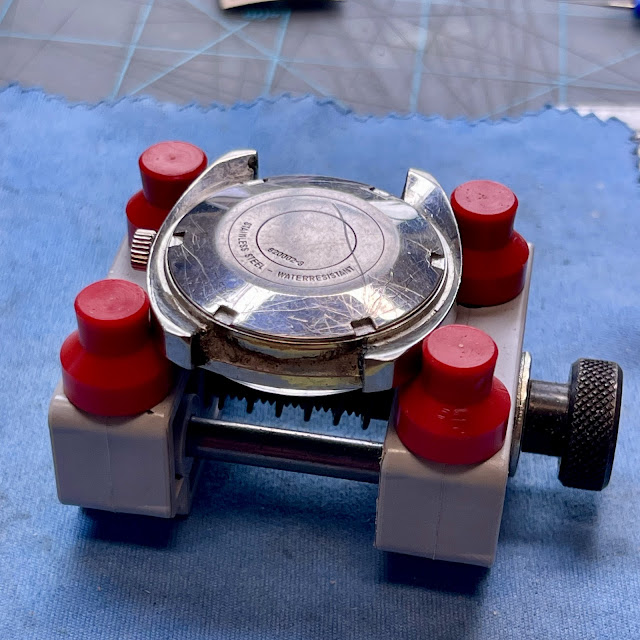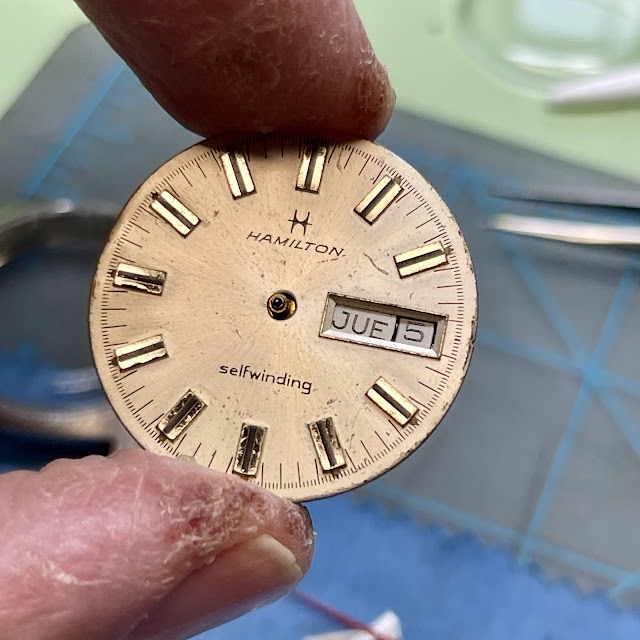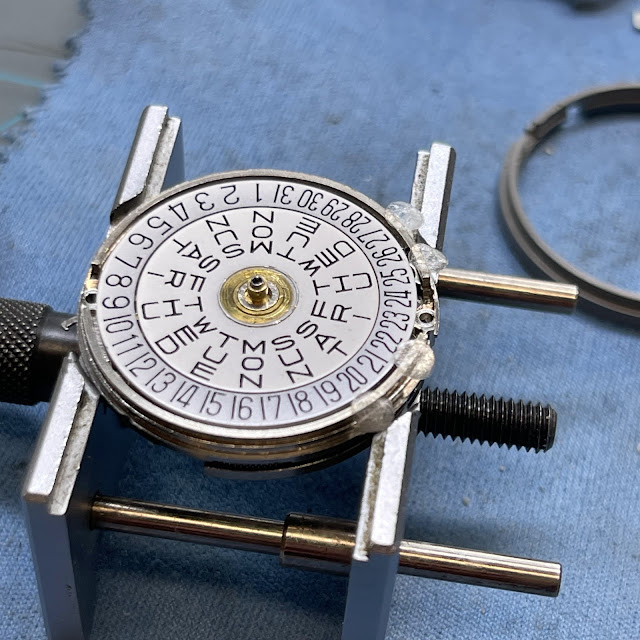Hamilton introduced calendar models in the early 1950s but if you if you see a Hamilton with a day and a date then you can be sure it's from the 1970s or later. There are quite a few of them out there but, to be honest, I don't find them all that desirable. It's not because I don't need to know what day it is, it's more a a result of the big and chunky 1970s styling.
Back in 2018 I did a post on a watch that looked a lot like an Auto Date Buccaneer. Today I get to do another post on a watch that is much more likely to be a Buccaneer.
The Buccaneer was introduced in 1973 and made for two years. It came in a stainless steel case with a matching bracelet - yours for $110 - that's a little over $700 in todays dollars, and probably more like $1,100 once Trump is finished making America "great".
In 1974 the priced was increased to $120. The Q/C II means the watch has a quick change setting capability so you can set the day and the date without moving the hour hand. The stem has the positions... the winding position, then you pull the crown out a little to set the day in one direction or the date in the other. Pull the crown out all the way and you can set the time.

My project watch arrived sans bracelet but appears to be in decent shape. Stainless steel cases can usually take a beating and this one shows it's seen some action over the last 50 years. I can tell from the catalog image that the bezel originally had a brushed finish. That could be restored but I don't have the wheels to do it. A good cleaning might be the best place to start.
Interestingly, this case back has the number 820002-3, which is different that the watch I did in 2018.
Based on the deep scratches on the case back, I'm going to assume the case back in on tight so I'll hold the case in a vice and used extra downward pressure on the case wrench.
Here's another interesting find, this watch has an 826 movement in it and not the 825 that I found in the 2018 watch. All these ETA movements look very similar and share a lot of parts but they are not all the same.
Looking closely at the hands, they were very close to the dial. That was a little odd. I have to pull them anyway to remove the dial. The dial is held on by two clamps that look like a backwards question mark. You rotate them out of the movement and that releases the dial feet.
Uh-oh - the other side is missing it's clamp. So there's nothing holding the dial in place. The hands were close to the dial because the dial lifted off the mainplate.
With the dial out of the way you can see the calendar and date wheels. They take up of the entire surface of the main plate so I'll have to figure out some way to secure the dial without using sticky "dial dots". You can tell from the two wheels that the date rotates clockwise and the day rotates counter clockwise.
The day wheel just lifts right off to reveal the complications that change the day and the date. There's a lot going on under the dial, that's for sure.
Disassembly starts with removing the hour wheel - this is what the hour hand is attached to. Once its out of the way you can see the cannon pinion and minute wheel. The cannon pinion drives the minute hand and the minute wheel synchronizes the hour wheel.
Piece by piece, all the parts are removed. At this point you can see the little u-shaped spring that presses on the index lever on the left side of the movement. This spring has a tendency to fling off into the ether and disappear forever - great care has to be used to not lose it.
Finally - the majority of the parts are removed from the front of the movement. I'll take out the balance jewels once I remove the balance from the other side
The rotor and framework are held on with two screws. Once they are out of the way the movement starts to look like your garden variety ETA movement. Should be smooth sailing from this point.
Here's another interesting twist... there's no markings on the mainplate to what ETA caliber this is based on. I expected to 2780 but there's nothing at all. I can also see the post that the missing dial foot lever would attached to is also missing. So I may need another mainplate to address the dial foot situation.
I have another Auto Date movement to see if I can use as a donor.
There's no rotor on it so I don't know if this is an 826 but it sure looks similar.
Nope - this setup is different from my project watch - I'd rather not get change out all of these parts. That could be a larger can of worms.
While everything is in the ultrasonic, I'll install a new EverTite crystal with a silver (white) reflector ring. The original crystal had some deep scratches that would be difficult to polish out. A new crystal will be a nice improvement.
Everything is cleaned and ready for reassembly - there are a lot of parts in this movement, half of them are just for the day and date complication.
The basic movement is back together and running with a nice motion. Let's see what the timer thinks of it.
It's running a little fast but the amplitude is great. The beat error is well within my personal specs but I should be able to easily adjust it. Notice the beat rate is faster than the usual 18000 beats per hour most pre-1969 models have.
Well, it turns out the hairspring stud won't move any further in the direction it needs to go so if I want to reduce the beat error I'll need to pull the balance from the balance cock. That would really tempt fate so I'm going to let sleeping dogs lie and just slow the watch down a smidgen. The beat error will have to do.
I advance the time until the date changes and then can set the hands at midnight. After working with the movement and hands, I can see the dial is too loose without something to hold the dial feet. So I need to think of something else to try.
The movement has two half-rings on the circumference that hold the dial off the movement. I'll use a few sticky dial dots to hopefully hold the dial down on the side without the dial foot lever.
You can see the four round dots applied to the movement. I'll fold them over to double up the thickness. Once the dial is pressed down, it should be enough to hold the dial in place. The round hole between the dots is where the dial foot goes through the movement.
Well this was more of a project than I was expecting but I think it turned out well. Only time will tell if the dial stays in place. If it moves the day of the week wheel will probably stop working and eventually the hour hand will hit an hour marker. We'll just have to see... there's not much I can do without another 826 movement.






















































